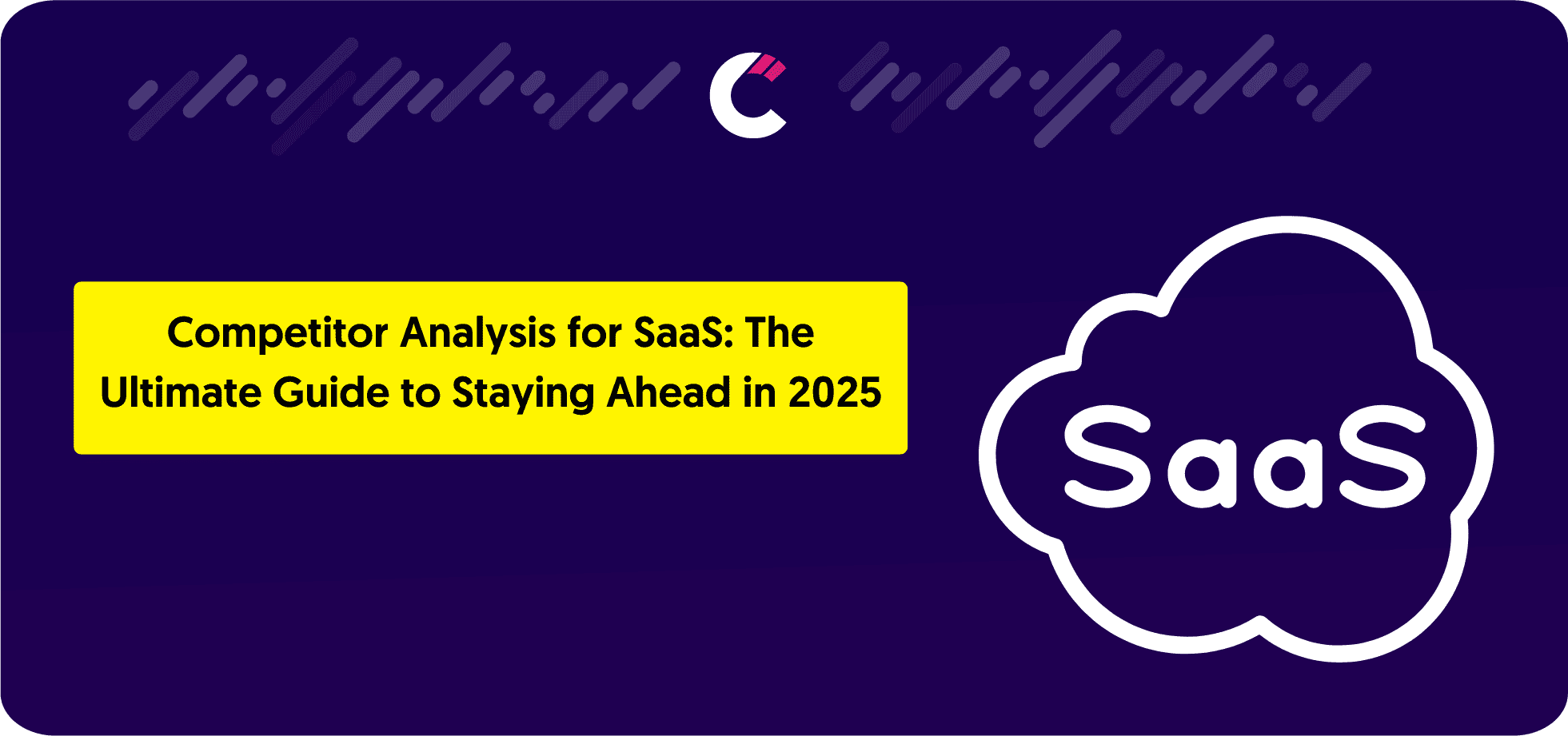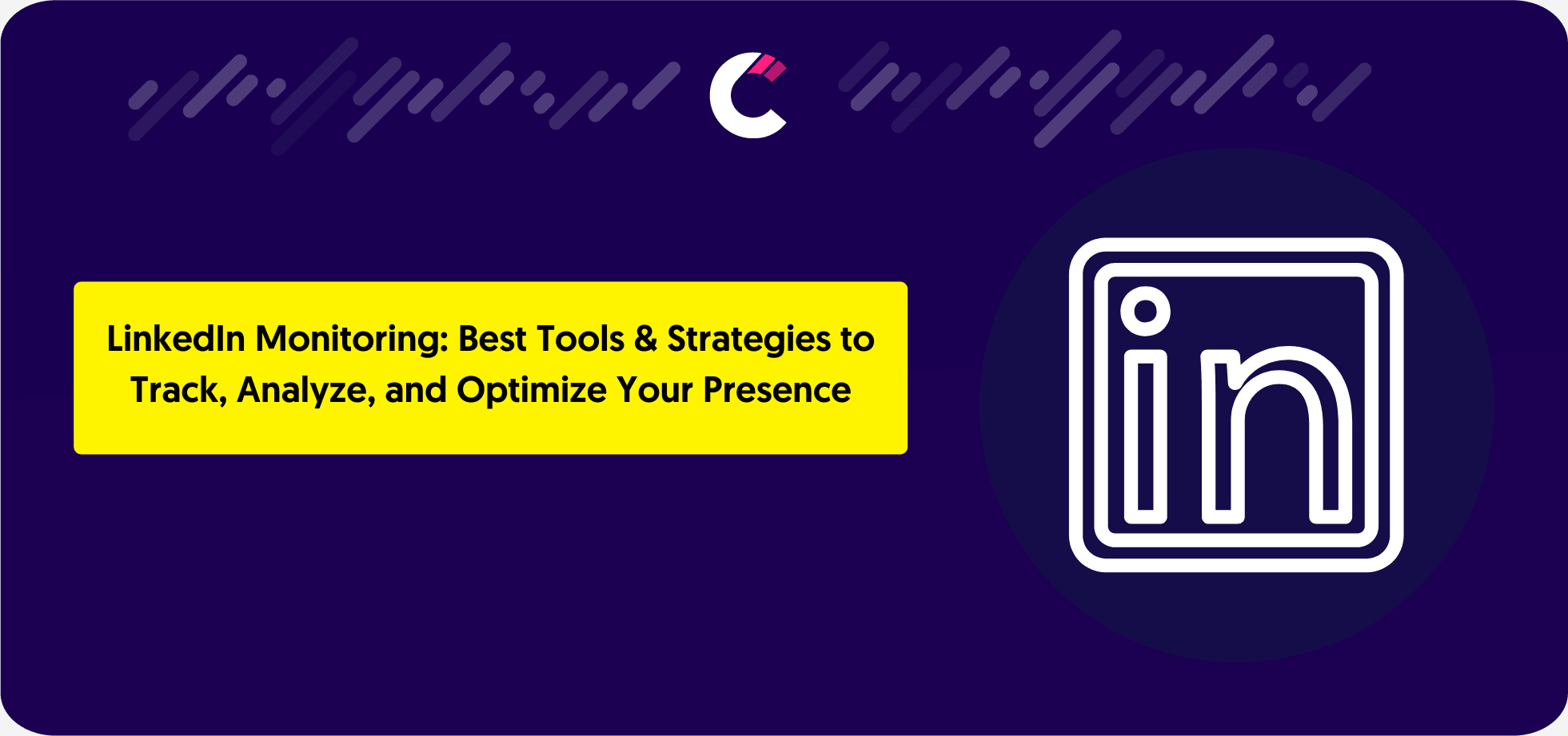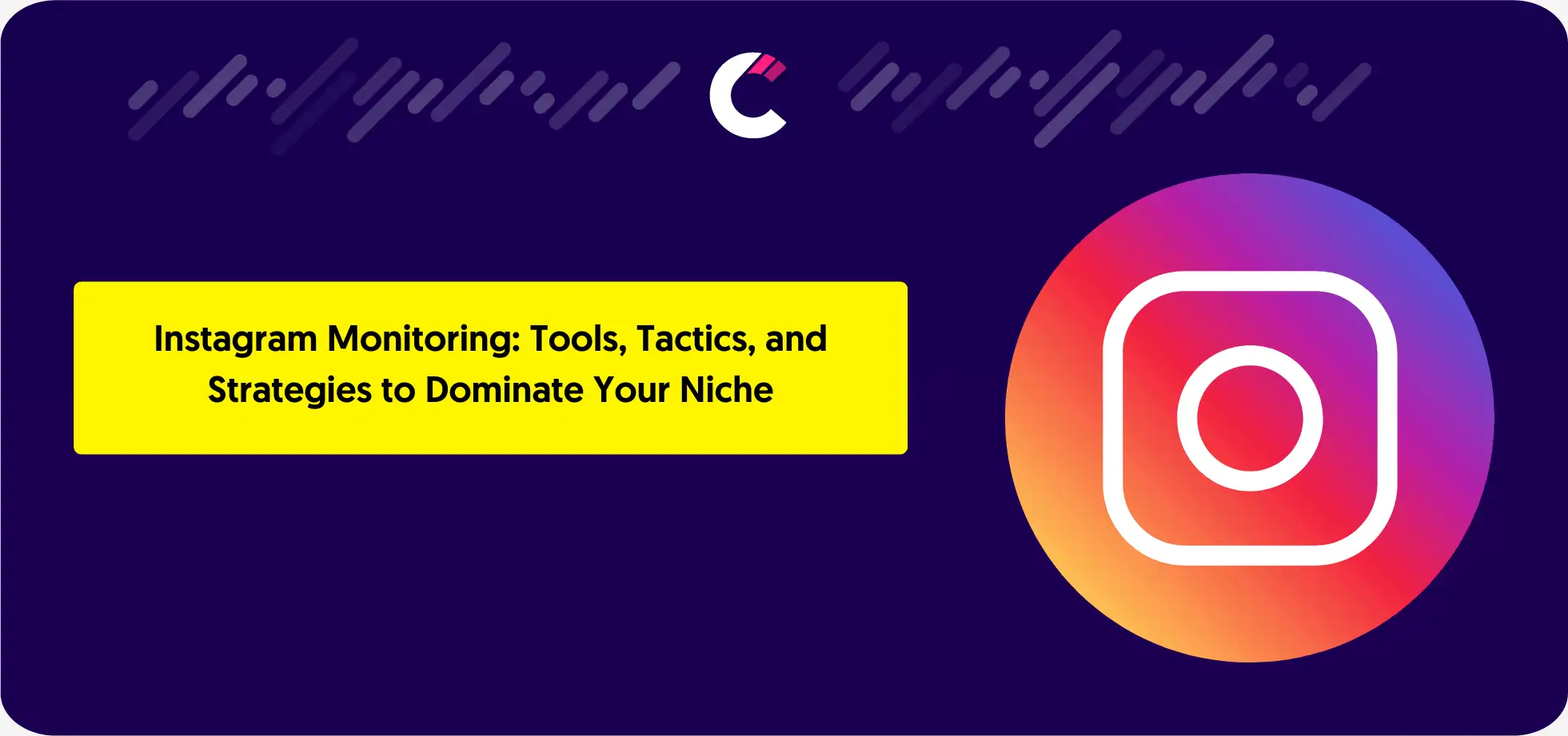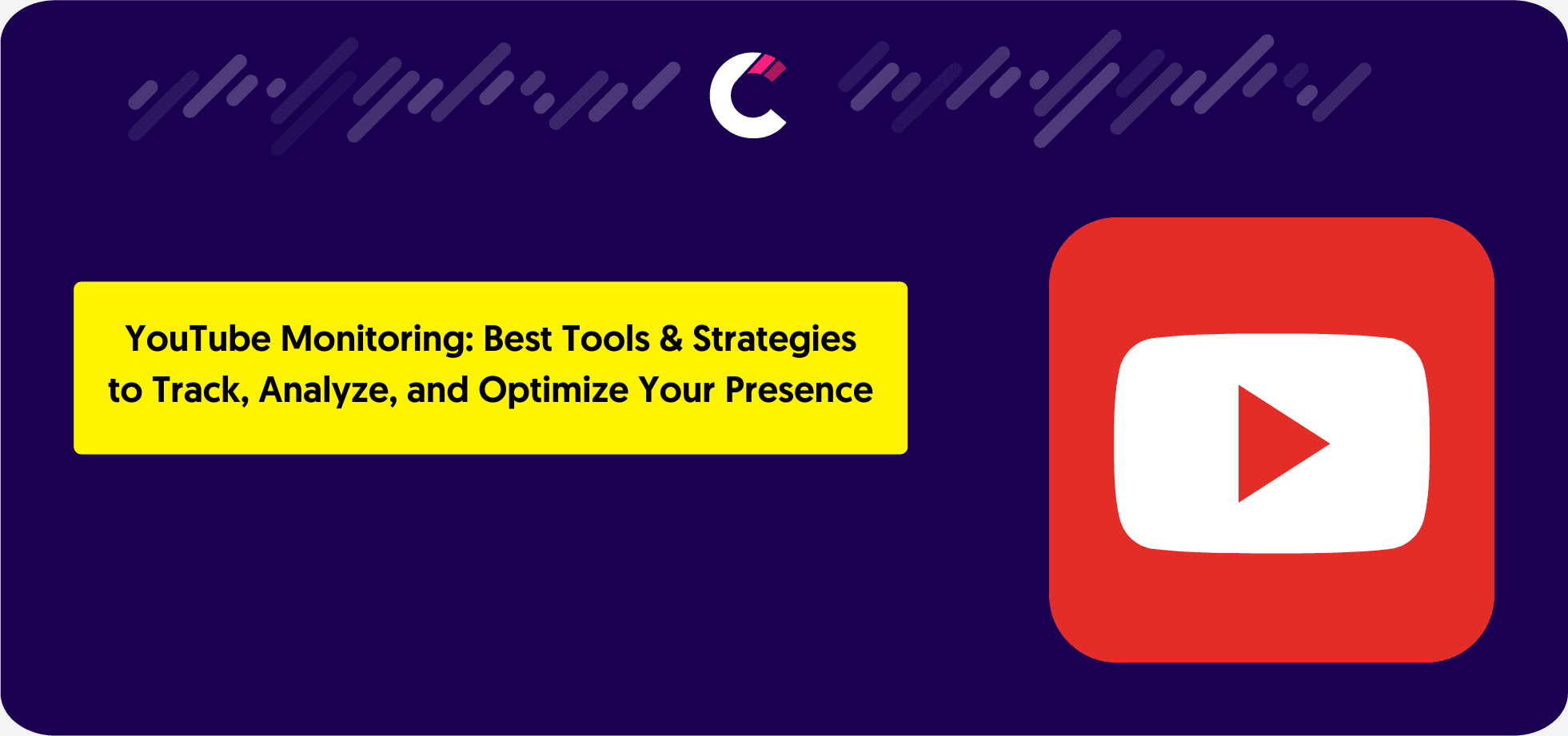The SaaS industry continues to grow at an unprecedented pace, with global revenues projected to exceed $250 billion by 2025. However, this growth brings intense competition, making it crucial for businesses to stay informed about their rivals.
Whether you’re a startup launching a new product or an established SaaS provider looking to maintain market leadership, competitor analysis is your compass for navigating the complex market dynamics.
This guide breaks down the essentials of competitor analysis for SaaS, offering a step-by-step approach to identifying opportunities, refining strategies, and staying ahead in this fast-evolving sector. From understanding your competitors’ strengths to discovering market gaps, you’ll gain the tools and insights to craft a winning strategy for 2025 and beyond.
What is Competitor Analysis for SaaS?
Competitor analysis for SaaS is the systematic evaluation of rival companies to understand their products, strategies, and market positioning.
It involves studying direct and indirect competitors to identify their strengths, weaknesses, and the value they bring to customers. The insights gained from this process enable SaaS businesses to benchmark their performance, adapt to market trends, and refine their strategies for long-term success.
For SaaS companies, where innovation and customer-centric solutions are paramount, competitor analysis serves as a roadmap to staying competitive.
It helps businesses identify key differentiators, uncover unmet customer needs, and improve their value proposition. By regularly monitoring the competitive landscape, companies can ensure they remain relevant and resilient in an industry that demands constant evolution.
Why is SaaS Competitor Analysis Important?
Conducting a SaaS competitive analysis is more than just an exercise in research—it’s a strategic tool that can significantly impact a company’s growth and sustainability.
Understanding the competitive landscape allows businesses to make informed decisions, identify gaps in the market, and deliver products that resonate with customers.
Benefits of Conducting Competitor Analysis for SaaS Companies:
1. Build a Unique Value Proposition (UVP)
A clear UVP sets your SaaS product apart from the competition. By analyzing competitors, you can pinpoint what makes their offerings attractive and identify opportunities to position your product with unique, compelling benefits.
2. Stay Relevant in the Market
Market trends evolve rapidly, and staying informed about competitor strategies ensures your product meets current demands. Regular competitor analysis helps businesses stay agile and adapt to changing customer expectations.
3. Stay Ahead of the Competition
By anticipating competitor moves, such as product launches or marketing campaigns, you can proactively refine your strategies and maintain a competitive edge.
4. Discover New Opportunities
Identifying gaps in competitors’ offerings or untapped market segments can open doors to innovation and growth, helping your SaaS business seize opportunities before others do.
5. Improve Customer Retention
Analyzing competitors’ customer reviews and feedback offers valuable insights into what keeps their users satisfied or dissatisfied. Use this knowledge to enhance your product and customer experience.
6. Understand Your Customer’s Needs
By studying how competitors address customer pain points, you gain a deeper understanding of your target audience. This ensures your product remains aligned with their expectations.
How to Conduct SaaS Competitor Analysis (Step-by-Step)
Step 1: Identify Your Competitors
Begin by listing both direct and indirect competitors.
Direct competitors offer similar products or services to your target audience, while indirect competitors may fulfill the same needs differently.
For example, if you’re in the project management niche, Asana and Trello would be direct competitors, while tools like Notion or Slack might be indirect.
Tools for Competitor Identification:
Use our free tool to find competitors. This tool allows you to find competitors to you in your niche for free using just keywords.
Step 2: Research Competitors’ Products and Services
Deep dive into your competitors’ offerings to understand their features, unique value propositions, and market positioning. Evaluate how they communicate their product benefits to their audience and track changes in their offerings.
Key Areas to Analyze:
- Feature Comparison: Compare functionalities to identify strengths, weaknesses, and potential gaps in their offerings.
- Value Propositions: Study how they position themselves in the market.
- Tracking Updates: Use tools like Competitors App to monitor product updates and feature changes in real-time.
Step 3: Analyze Competitors’ Marketing Strategies
A robust marketing strategy often defines a SaaS company’s success. Investigate how your competitors attract and engage their audience through SEO, content, and social media.
Focus Areas:
- SEO and Keyword Analysis: Tools like Ahrefs or SEMRush can reveal the keywords your competitors rank for and their backlink profiles.
- Content Marketing: Examine their blog topics, content formats, and engagement metrics to identify what resonates with their audience.
- Social Media Monitoring: Platforms like Hootsuite and BuzzSumo can help you track your competitors’ campaigns and audience engagement.
- Competitors App: Simplifies tracking competitor marketing strategies, providing actionable insights.
Step 4: Evaluate Customer Interactions
Customer feedback is a goldmine for understanding competitor performance. Analyzing reviews and testimonials can reveal recurring customer complaints, areas of satisfaction, and opportunities to differentiate.
Techniques:
- Review Analysis: Platforms like G2 Crowd and Trustpilot provide insights into what customers love or dislike about your competitors.
- Sentiment Analysis: Use tools like Competitors App to track customer sentiment in real-time and identify trends.
Step 5: Compare Strengths, Weaknesses, and Gaps
Conduct a SWOT analysis for your competitors to evaluate their strengths, weaknesses, opportunities, and threats. Simultaneously, perform a gap analysis to uncover areas where you can outperform them.
Example:
If a competitor lacks integrations with specific tools, but customers frequently request them, this represents an opportunity for your product.
Step 6: Assess Market Position and Pricing
Evaluate how competitors price their products and where they stand in the market. Consider their pricing strategies, such as freemium models or tiered plans, and benchmark them against your own.
Tools to Use:
Price benchmarking tools and competitor tracking platforms like Competitors App can streamline this process and identify pricing trends.
Step 7: Adapt and Refine Your Strategy
Use your findings to iterate on your business strategies. Update your SEO approach, refine your marketing tactics, and enhance your product features to stay ahead. Competitor analysis is not a one-time activity—it’s an ongoing process that requires regular updates.
What Should a SaaS Competitive Analysis Include?
A thorough SaaS competitive analysis goes beyond basic research. It should encompass detailed evaluations of various aspects of your competitors’ strategies, products, and market positioning.
Here’s what a comprehensive analysis should include:
Competitor Profiles
Create detailed profiles for each competitor, including their business model, product offerings, target audience, and key differentiators. These profiles help you understand the broader landscape and identify trends in your industry.
Unique Selling Propositions (USPs)
Analyze what sets your competitors apart from others in the market. Understanding their USPs allows you to identify areas where your SaaS product can provide unique value.
Marketing and Content Strategy
Analyze your competitors’ marketing efforts, including SEO, content marketing, and paid campaigns, to understand which channels they prioritize and how they engage their audience. A SaaS SEO agency can provide in-depth insights into their organic growth strategies, keyword targeting, and backlink profiles. Tools like SEMrush and Competitors App can further help you uncover their most effective tactics and refine your own approach.
Keyword Research
Dive into the keywords your competitors target. Understanding their keyword strategy can reveal which terms drive traffic to their website and help you optimize your own SEO efforts.
Market Share Analysis
Evaluate your competitors’ market positions by assessing their customer base, revenue, and growth rates. This helps you gauge their dominance in the market and identify opportunities to capture more market share.
Competitive Analysis Frameworks for SaaS
Leveraging the right frameworks is essential for conducting a structured and insightful SaaS competitive analysis. These frameworks provide a systematic approach to evaluating your competitors’ strategies and identifying opportunities for your business.
SWOT Analysis
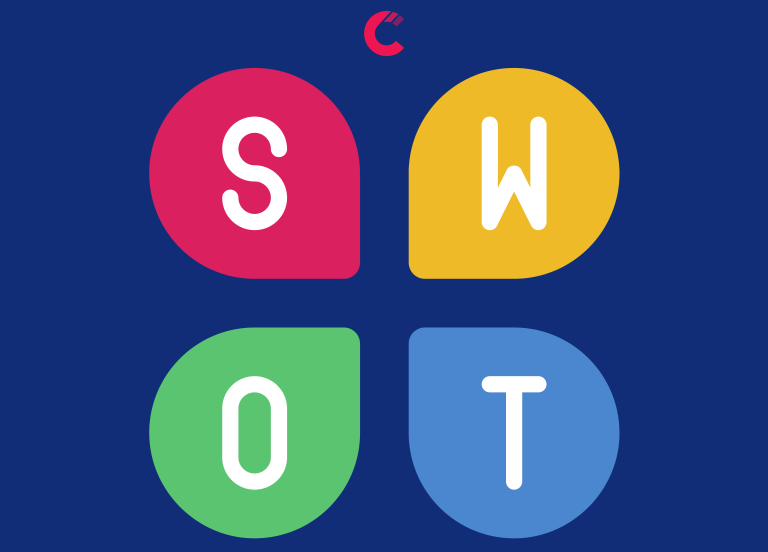
SWOT (Strengths, Weaknesses, Opportunities, Threats) analysis helps you assess competitors on four key dimensions. Strengths and weaknesses focus on internal factors like product features and pricing, while opportunities and threats consider external elements such as market trends and industry challenges.
By applying SWOT to each competitor, you can uncover actionable insights to refine your strategy.
Porter’s Five Forces
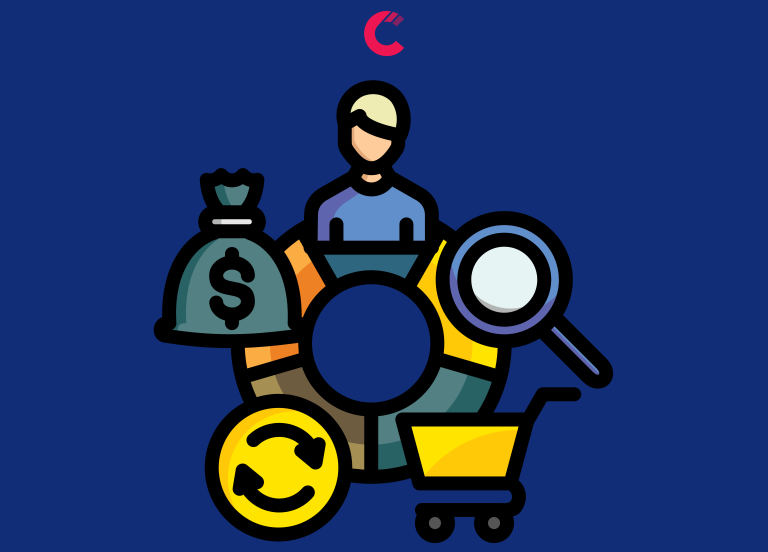
This framework evaluates the competitive intensity within your industry. It examines five critical forces: the threat of new entrants, bargaining power of buyers, bargaining power of suppliers, the threat of substitute products, and industry rivalry.
For SaaS companies, this helps assess how factors like customer demand and market saturation impact competitiveness.
Growth-Share Matrix

The Growth-Share Matrix categorizes competitors based on market share and market growth. It identifies which companies are industry leaders, rising stars, or niche players. This analysis can inform strategic decisions about product positioning and investment priorities.
Perceptual Mapping

Perceptual mapping visually compares competitors based on key attributes like pricing, features, or customer satisfaction. This tool helps identify how your SaaS product is perceived relative to others, revealing gaps you can exploit to differentiate your offering.
Tools for SaaS Competitor Analysis
The right tools are essential for conducting a thorough and efficient SaaS competitive analysis.
These tools help streamline processes like monitoring competitors’ SEO strategies, tracking social media campaigns, analyzing customer feedback, and identifying product updates. Below are some of the most effective tools categorized by their purposes:
SEO and Marketing Tools
For understanding competitors’ search engine performance and marketing strategies:
- SEMRush: Offers in-depth keyword analysis, backlink tracking, and competitor traffic insights. It’s particularly valuable for optimizing your SEO and paid advertising efforts.
- Ahrefs: Known for its comprehensive backlink data and content gap analysis, Ahrefs helps uncover opportunities to outrank competitors.
- Moz: Focused on on-page SEO and domain authority tracking, Moz simplifies SEO research and performance monitoring.
Social Media Monitoring Tools
For analyzing how competitors engage with their audience and run campaigns:
- BuzzSumo: Tracks top-performing content and social shares to identify trends in your competitors’ content strategy.
- Hootsuite Streams: Provides real-time monitoring of competitors’ social media activities, helping you track audience engagement and campaign effectiveness.
Customer Sentiment and Feedback Platforms
For evaluating customer perceptions of your competitors’ products:
- G2 Crowd: Aggregates user reviews and ratings, offering a detailed look at customer satisfaction and pain points.
- Trustpilot: Provides a comprehensive overview of customer feedback, highlighting areas where competitors excel or face challenges.
Product Feature Comparison Tools
For tracking changes in competitors’ products and identifying feature gaps:
- Competitors App: Tracks updates to competitors’ websites, product features, and ad campaigns, providing actionable insights. This tool is indispensable for SaaS companies aiming to stay ahead in the market.
Market and Trend Analysis Tools
For identifying larger market trends and understanding industry dynamics:
- Google Trends: Helps track search trends related to your industry, giving insights into emerging customer interests.
- Competitors App: Offers market insights by analyzing competitors’ strategies and trends, enabling proactive adjustments.
To explore more tools and their capabilities, check out this comprehensive guide to competitive analysis tools. It provides a detailed breakdown of features and advantages, helping you choose the best tools for your SaaS business.
Using Competitors App for SaaS Competitive Analysis
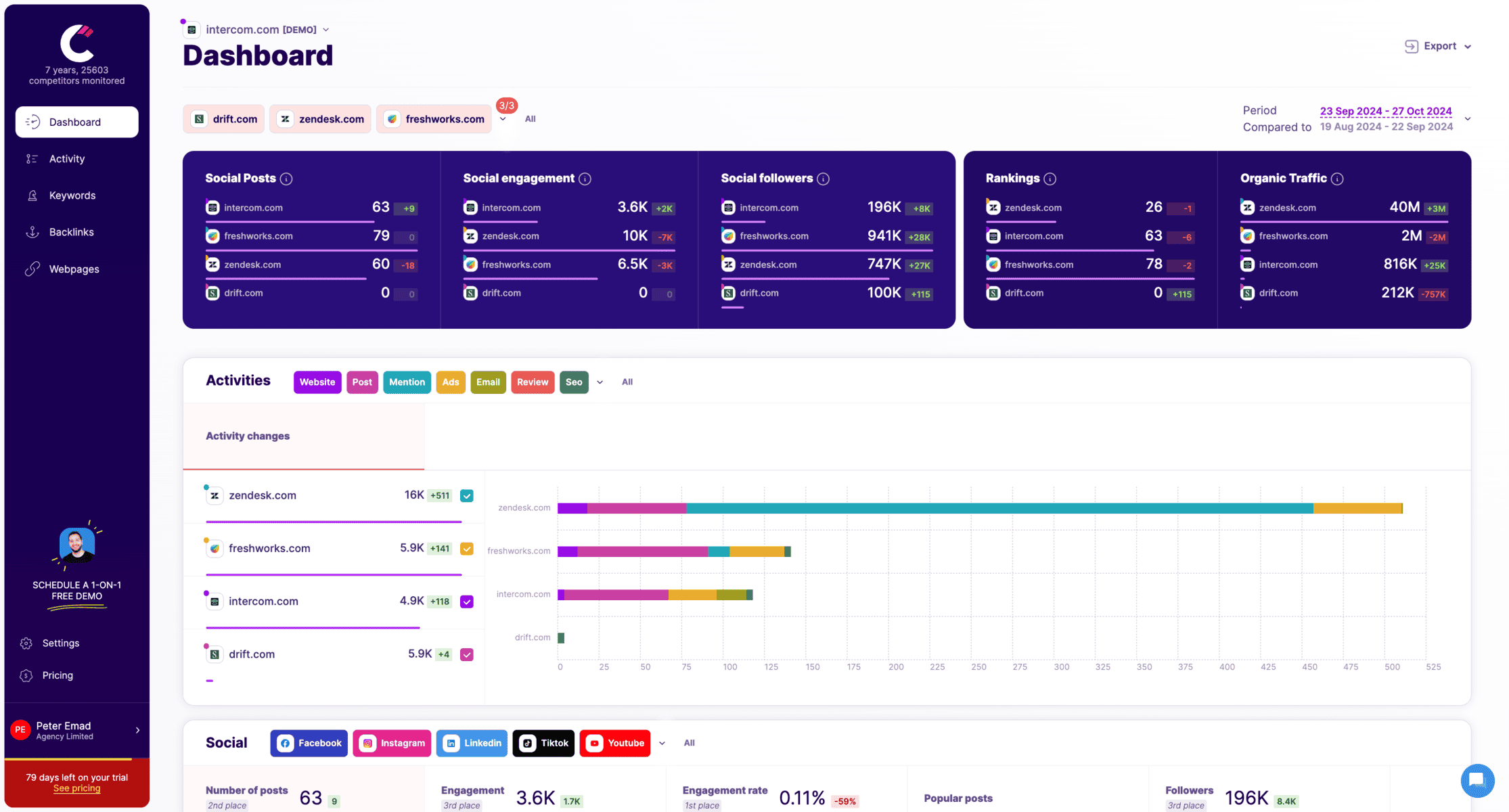
When it comes to efficient and comprehensive SaaS competitor analysis, Competitors App stands out as an indispensable tool. It simplifies the process of tracking competitors across multiple dimensions, providing actionable insights that help SaaS companies refine their strategies and stay ahead in the market.
Features Overview
Competitors App offers an array of features tailored to the needs of SaaS businesses, including:
- Competitor Tracking: Monitors changes to competitors’ websites, such as updates to features, pricing, or product descriptions, in real time.
- Ad Campaign Monitoring: Tracks your competitors’ ad campaigns, providing insights into their paid marketing strategies.
- Content Updates: Alerts you to new blog posts, articles, or content changes on competitor websites.
- Automated Reporting: Generates periodic reports to help you identify trends and adjust your strategy proactively.
Real-Time Insights for Decision-Making
The tool enables SaaS businesses to make informed decisions with real-time data. For instance, if a competitor launches a new feature, you can quickly evaluate its impact and plan your response.
Benefits of Using Competitors App
- Save Time: Automation reduces the manual effort required for competitor tracking.
- Stay Proactive: Receive alerts about changes, enabling you to adapt faster than your competitors.
- Strategic Advantage: Use comprehensive insights to uncover gaps and opportunities in the market.
- Holistic Analysis: Combines website updates, ads, and content changes in one platform for a complete picture of your competitors.
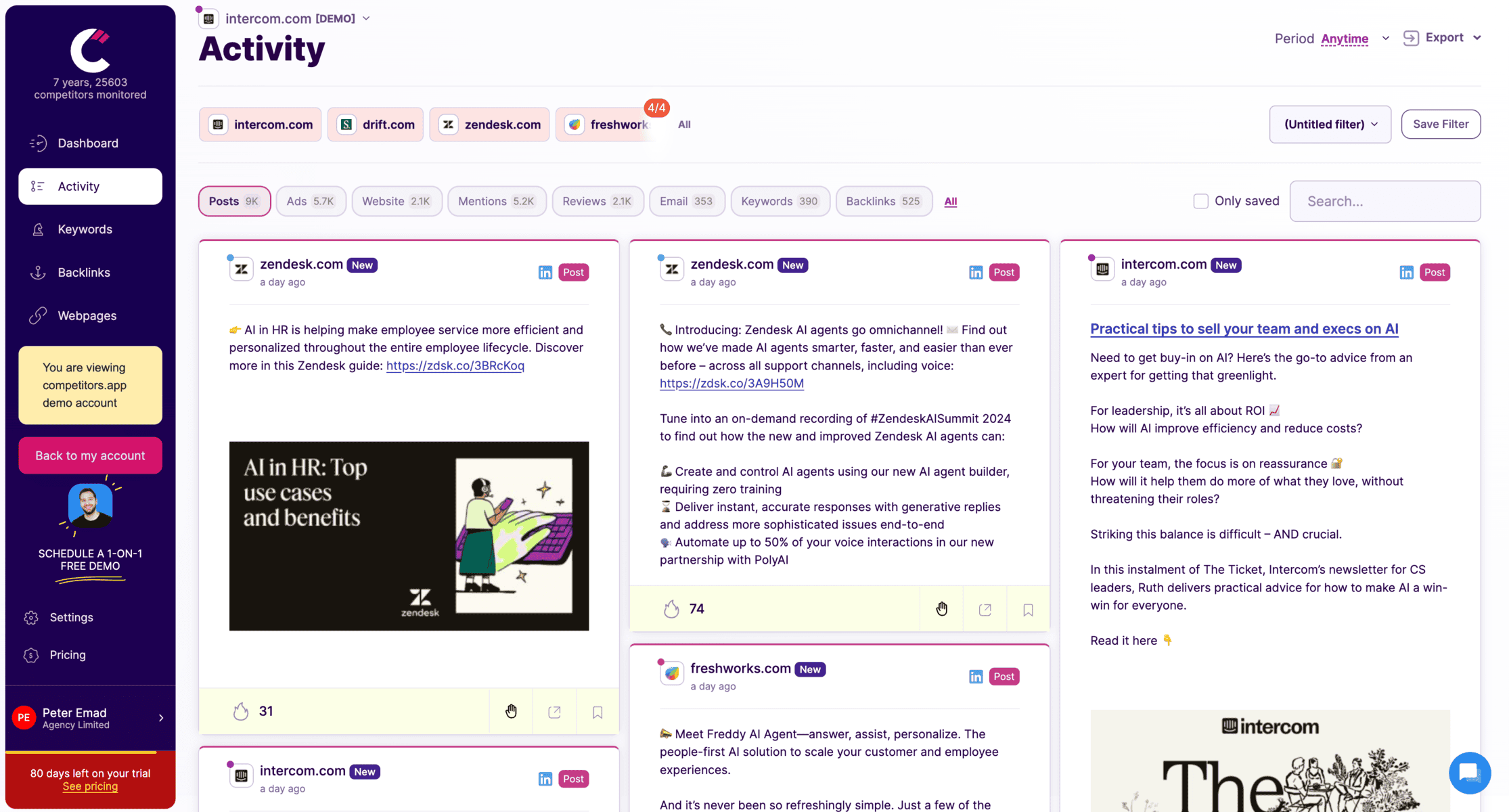
Tracks competitor social media updates across LinkedIn, Facebook, Twitter, and more.
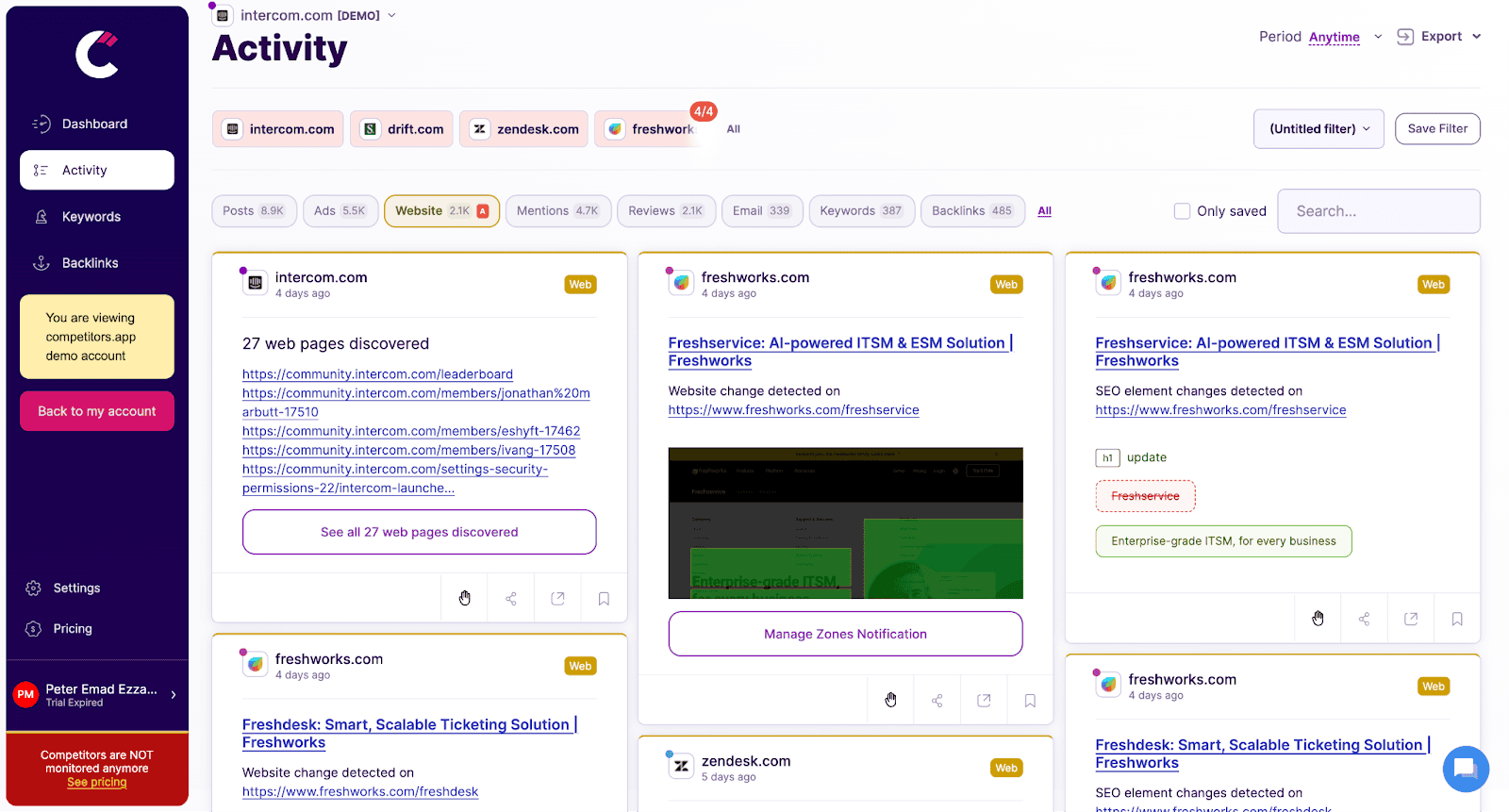
Monitors changes on competitors’ websites, such as product updates, pricing adjustments, and new messaging, providing instant alerts to help sales teams respond promptly.
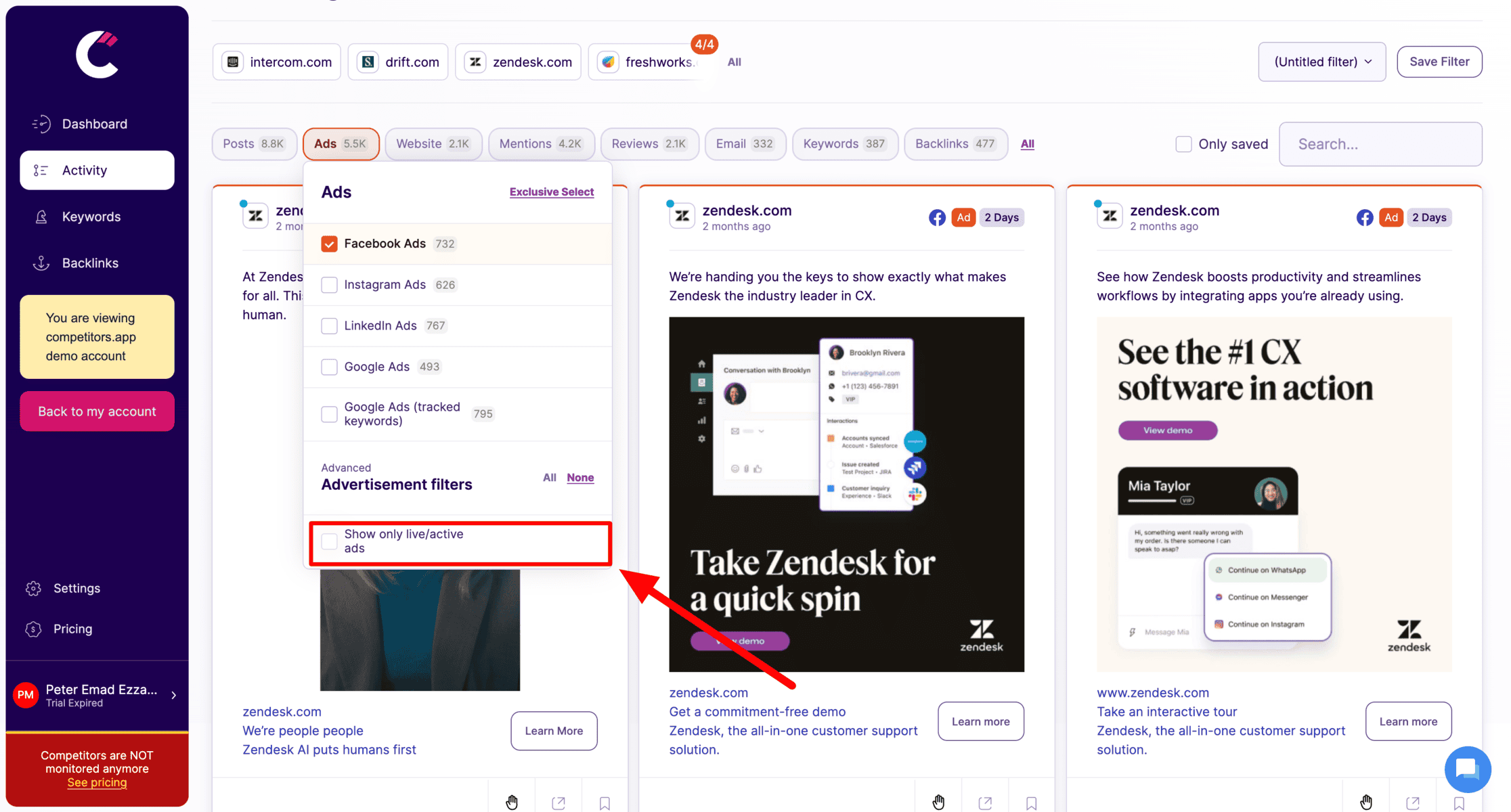
Tracks digital ad campaigns across platforms like Google Ads, Facebook, LinkedIn, and Instagram. It provides details on ad creatives, spending, and performance metrics, helping teams analyze successful ad strategies.

Analyzes competitors’ keyword strategies, organic rankings, and backlinks, allowing teams to refine their own SEO tactics and boost search visibility.

Tracks competitors’ email campaigns, including content, frequency, and engagement metrics, helping sales teams understand email tactics that drive engagement and conversions.
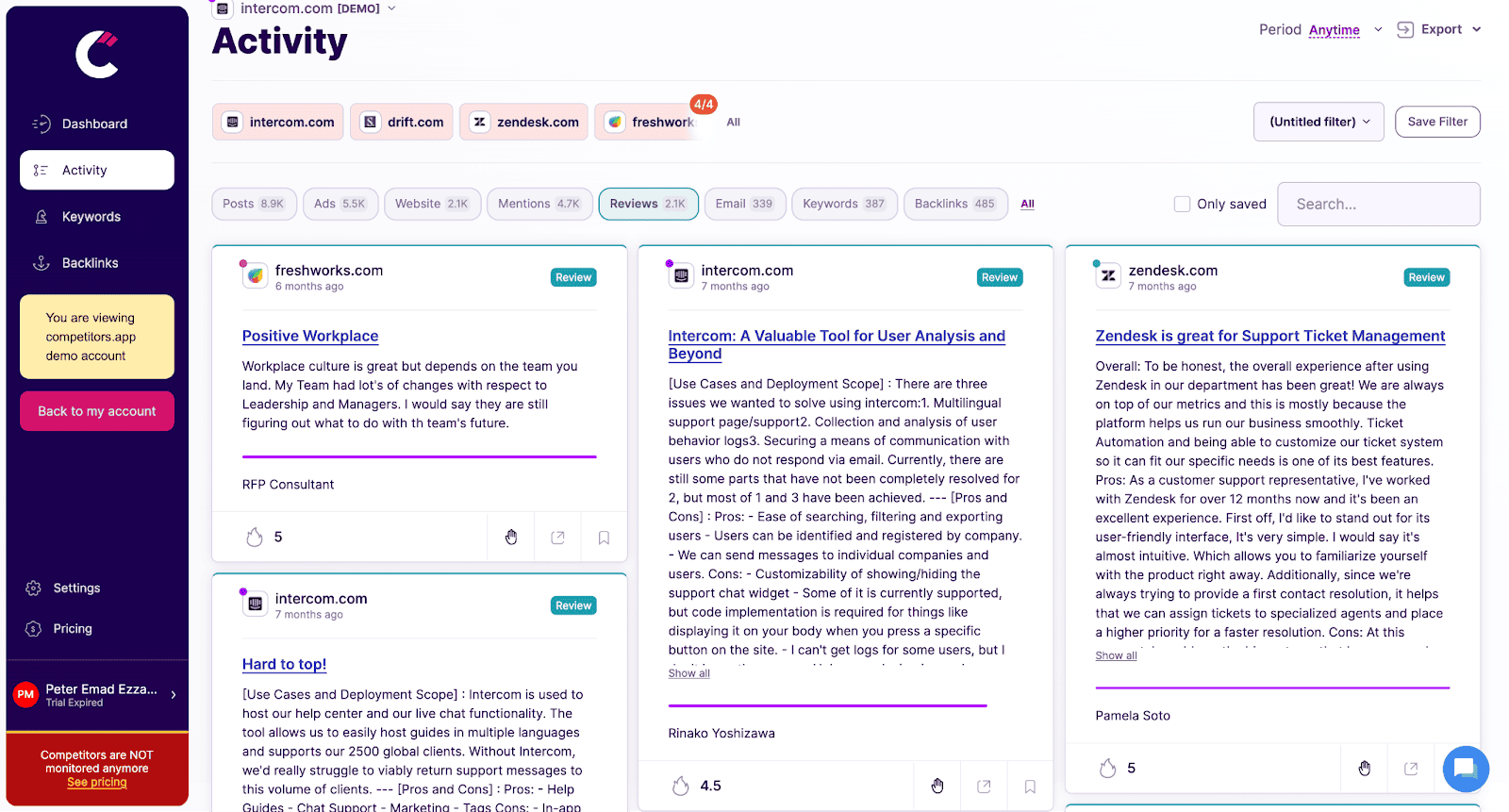
Analyzes customer reviews and ratings for competitors, providing insights into customer feedback, pain points, and product strengths, helping teams craft better sales pitches.
How Top SaaS Companies Perform Competitor Analysis
Leading SaaS companies employ robust strategies to stay ahead in an ever-competitive market. By analyzing their competitors and leveraging data-driven insights, they refine their products, marketing approaches, and customer engagement.
Here’s how top SaaS players conduct competitor analysis based on credible case studies:
Slack’s Competitive Strategy
Slack’s ability to compete with Microsoft Teams showcases its strategic use of competitor analysis. A case study by Harvard Business School highlights how Slack differentiates itself in a competitive landscape dominated by enterprise giants like Microsoft. Slack focuses on delivering a seamless user experience, prioritizing intuitive design, and offering integrations that cater to diverse team workflows.
- Key Insight: Slack emphasizes innovation and ease of use, ensuring its product stands out even against larger competitors.
Monday.com’s Marketing Excellence
While not directly featured in academic case studies, Monday.com’s marketing success is often cited in industry analysis. The company excels at targeting niche audiences through data-driven campaigns. By analyzing competitors’ keyword strategies and content performance, Monday.com adapts its messaging to attract and engage specific user segments effectively.
- Key Insight: Monday.com uses insights from competitor strategies to craft personalized marketing campaigns that resonate with its target audience.
Salesforce’s Long-Term Growth Approach
Salesforce, a pioneer in CRM, leverages competitor analysis to maintain its leadership. According to an analysis by Hivelr, Salesforce continuously innovates its product offerings and expands its ecosystem to counteract competitive pressures. By tracking competitors’ moves and understanding market trends, Salesforce aligns its strategy with long-term growth objectives.
- Key Insight: Salesforce combines innovation and competitive intelligence to strengthen its market position and adapt to changing customer demands.
These examples illustrate the importance of tailored competitor analysis for SaaS companies. Each company leverages insights uniquely to address their business goals, whether it’s enhancing product features, refining marketing strategies, or securing long-term market dominance.
Thriving in a Competitive SaaS Industry
In the highly dynamic SaaS industry, staying ahead requires more than just offering a great product. Companies must continuously adapt, innovate, and maintain a customer-centric approach to outpace competitors.
Here are strategies to help your SaaS business thrive:
1. Focus on Innovation and Adaptability
SaaS companies that succeed are those that consistently evolve their offerings to meet changing customer needs. Regularly monitoring competitors and market trends allows you to anticipate shifts and refine your product roadmap accordingly.
2. Prioritize Customer-Centric Approaches
Understanding your customers’ pain points and delivering solutions tailored to their needs can set your SaaS business apart. Competitor analysis helps identify gaps in the market and unmet demands that you can address.
3. Leverage Data-Driven Tools
Tools like Competitors App provide actionable insights that streamline your strategies. By automating competitor tracking and analysis, you can focus on implementing data-driven decisions that yield measurable results.
4. Build a Robust Value Proposition
Your unique value proposition (UVP) should communicate why customers should choose your SaaS product over others. Regularly revisiting your UVP ensures it stays relevant and resonates with your target audience.
5. Embrace Continuous Improvement
Competitor analysis is an ongoing process. Use insights from your analysis to refine your marketing campaigns, improve your product features, and enhance customer retention strategies. Iterative improvement is key to long-term success.
Thriving in the SaaS industry requires a combination of strategic foresight, customer focus, and the effective use of tools and data. With a well-defined plan and continuous adaptation, your business can maintain a competitive edge in this rapidly evolving landscape.
Frequently Asked Questions (FAQ)
What is SaaS competitor analysis?
SaaS competitor analysis involves evaluating the strategies, strengths, and weaknesses of competitors in the Software as a Service (SaaS) industry. It includes analyzing competitors’ products, marketing efforts, customer feedback, and overall market positioning to uncover opportunities for your business to differentiate and grow.
Why is competitor analysis important for SaaS companies?
Competitor analysis is essential for SaaS companies because it helps them:
- Build a unique value proposition (UVP)
- Stay relevant in a fast-changing market
- Identify gaps and opportunities
- Improve customer retention by addressing unmet needs
- Adapt to industry trends and customer preferences
What are the key steps to conduct SaaS competitor analysis?
The key steps include:
- Identifying direct and indirect competitors
- Researching their products, services, and marketing strategies
- Analyzing customer interactions, including reviews and feedback
- Performing SWOT and gap analyses to identify opportunities
- Refining strategies based on insights from the analysis
What tools are best for SaaS competitor analysis?
Top tools for SaaS competitor analysis include:
- SEMRush and Ahrefs for SEO and keyword tracking
- BuzzSumo and Hootsuite Streams for social media monitoring
- Competitors App for comprehensive tracking of website updates, ads, and content. It provides real-time updates, automated reporting, and actionable insights tailored to SaaS businesses.
- G2 Crowd and Trustpilot for customer feedback analysis
How often should SaaS companies conduct competitor analysis?
Competitor analysis should be an ongoing process, but detailed evaluations are recommended every 3–6 months. Tools like Competitors App provide real-time updates, ensuring you stay informed about competitors’ moves without waiting for periodic reviews.
What frameworks can be used for SaaS competitor analysis?
Common frameworks include:
- SWOT Analysis: Assessing strengths, weaknesses, opportunities, and threats
- Porter’s Five Forces: Evaluating industry dynamics and competition intensity
- Growth-Share Matrix: Categorizing competitors based on market growth and share
- Perceptual Mapping: Visualizing competitors’ positioning based on attributes like pricing or features
How can SaaS companies stay ahead in a competitive market?
To stay competitive, SaaS companies should:
- Continuously innovate and adapt their product offerings
- Focus on customer-centric strategies
- Leverage tools like Competitors App for actionable insights
- Regularly refine their marketing and pricing strategies
- Monitor and address gaps in competitors’ offerings
